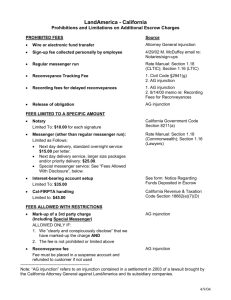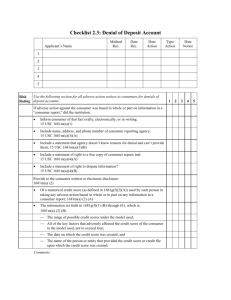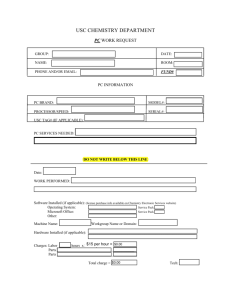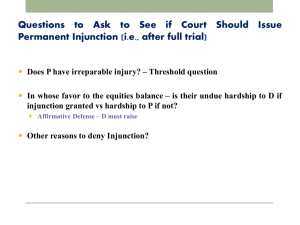The use of injunctions in labor disputes
advertisement
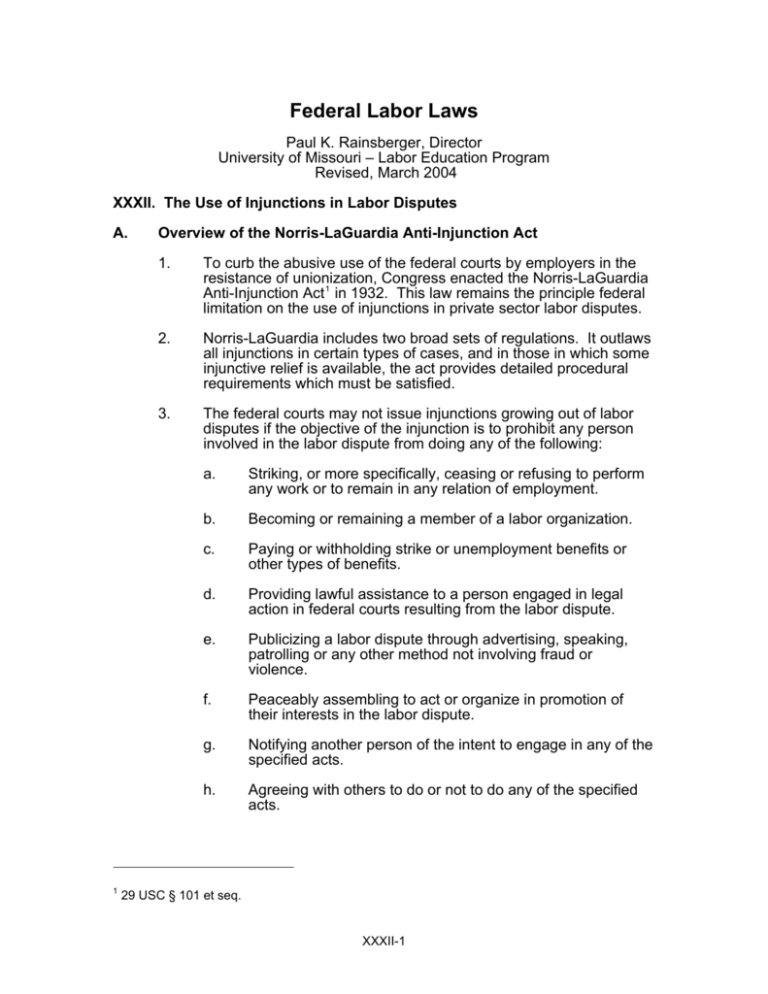
Federal Labor Laws Paul K. Rainsberger, Director University of Missouri – Labor Education Program Revised, March 2004 XXXII. The Use of Injunctions in Labor Disputes A. 1 Overview of the Norris-LaGuardia Anti-Injunction Act 1. To curb the abusive use of the federal courts by employers in the resistance of unionization, Congress enacted the Norris-LaGuardia Anti-Injunction Act 1 in 1932. This law remains the principle federal limitation on the use of injunctions in private sector labor disputes. 2. Norris-LaGuardia includes two broad sets of regulations. It outlaws all injunctions in certain types of cases, and in those in which some injunctive relief is available, the act provides detailed procedural requirements which must be satisfied. 3. The federal courts may not issue injunctions growing out of labor disputes if the objective of the injunction is to prohibit any person involved in the labor dispute from doing any of the following: a. Striking, or more specifically, ceasing or refusing to perform any work or to remain in any relation of employment. b. Becoming or remaining a member of a labor organization. c. Paying or withholding strike or unemployment benefits or other types of benefits. d. Providing lawful assistance to a person engaged in legal action in federal courts resulting from the labor dispute. e. Publicizing a labor dispute through advertising, speaking, patrolling or any other method not involving fraud or violence. f. Peaceably assembling to act or organize in promotion of their interests in the labor dispute. g. Notifying another person of the intent to engage in any of the specified acts. h. Agreeing with others to do or not to do any of the specified acts. 29 USC § 101 et seq. XXXII-1 i. 4. Inducing without fraud or violence others to engage in any of the specified acts. 2 In cases in which an injunction or temporary restraining order may be issued, Norris-LaGuardia requires that specific procedural steps be followed by the federal court considering the case. a. Any temporary restraining order or injunction issued must be supported by detailed findings of fact made and filed by the court prior to the issuance of the order. The order must be confined to the prohibition of specific unlawful acts. 3 b. A party which has failed to comply with legal obligations involving the labor dispute or which has failed to attempt to resolve the dispute through negotiations, mediation or arbitration may not be granted injunctive relief. 4 c. Except for temporary restraining orders of five days or less, a person against whom an injunction is sought and the local law enforcement officials must be given notice and an opportunity for a hearing at which sworn testimony in support of the request for an injunction may be cross-examined. 5 d. Any injunction issued must be based on specific findings of fact supported by testimony given under oath. 6 e. The findings of fact must establish each of the following points: 2 29 USC § 104. 3 29 USC § 109. 4 29 USC § 108. 5 29 USC § 107. 6 Ibid. 1) That illegal acts have been committed or threatened, 2) That irreparable harm will occur if the injunction is not issued, 3) That greater harm will result if no injunction is issued than if one is, 4) That there is no adequate remedy at law for the threatened illegal acts, and 5) That law enforcement officials are unable or unwilling to furnish adequate protection. 7 XXXII-2 f. B. C. Temporary restraining orders of five days or less may be issued without prior notice if the court finds that irreparable harm will occur without such relief. The party seeking a temporary restraining order must post a surety bond to assure that the costs and expenses of the defendant can be paid should the court later find that the restraining order was issued improperly. 8 5. Norris-LaGuardia applies only to labor disputes. Whether an injunction may be issued by federal courts in other types of cases is beyond the scope of the act. 6. The Act also prohibits the enforcement of "yellow dog" contracts in federal courts. Yellow dog contracts are individual contracts of employment under which a worker agrees not to join a labor organization or agrees to terminate the employment relationship if the worker joins a labor organization. 9 Injunctions Permitted under Norris-LaGuardia 1. While Norris-LaGuardia provides broad protection against the use of injunctions in peaceful labor disputes, there are a number of situations in which injunctions may be issued. 2. Specific acts of violence or fraud may be prohibited by injunction under the terms and procedures of the Act. 3. The Supreme Court has added an exception to the prohibition against injunctions in cases involving wildcat strikes. Under the Boys Market exception, an employer may seek injunctive relief against a wildcat strike if the employer is willing to submit the underlying issue to final and binding arbitration. 10 Relationship between NLRB Injunctions and Norris-LaGuardia 1. The practical effect of the removal of federal court jurisdiction to issue injunctions in labor disputes was substantially reversed with passage of the Taft-Hartley Act of 1947. 2. Under Sections 10(j) and 10(l) of Taft-Hartley, the National Labor Relations Board is given the power to seek injunctions against the commission of unfair labor practices. Since most forms of pressure used in labor disputes are subject to regulation under the unfair labor practice provisions of Taft-Hartley, these sections introduce a new source of injunctive power. 7 Ibid., (a)—(e). 8 29 USC § 107, proviso. 9 29 USC § 103. 10 Boys Market, Inc. v. Retail Clerks Local 770, 398 U.S. 235, 74 LRRM 2257 (1970). XXXII-3 3. D. E. a. Under Section 10(j), the Board is given discretionary power to seek an injunction against the commission of any unfair labor practice. 11 b. Under Section 10(l), the Board is required to seek injunctive relief against violations of Sections 8(b)(4)(secondary pressure) and 8(b)(7)(recognition picketing). 12 c. A judicially enforceable cease and desist order issued as a remedy for an unfair labor practice also has the same effect as an injunction, even though such an order will not be issued until the completion of administrative procedures. In cases involving recognition picketing and secondary strikes and pickets, the NLRB functions as a convenient ally to the employers affected. While Norris-LaGuardia generally prevents the employer from seeking injunctive relief against such picketing, Taft-Hartley requires that the NLRB seek exactly the same relief. State Court Jurisdiction to Issue Injunctions 1. Norris-LaGuardia restricts the procedures used by federal courts in injunction cases. State courts retain the ability to issue injunctions, subject to procedural requirements imposed by the state. Most states have enacted laws similar to the federal Norris-LaGuardia Act. 13 2. While many of the rights of workers and unions to engage in protected concerted activity are established by federal law, the states still retain an interest in labor disputes. The states are prevented from acting in a manner inconsistent with the substantive rights and obligations of Taft-Hartley, but the state courts retain jurisdiction over matters of substantial state concern, such as the need to maintain public order and safety. 3. The state courts may also hear and decide cases which must be decided under principles of federal law, as it has developed under Section 301. In these cases, the states must apply the appropriate federal standards. For example, the Boys Market exception would limit the enforcement of a no-strike clause in state court. National Emergency Disputes 1. Title II of the Taft-Hartley Act created special procedures for the resolution of labor disputes if, in the opinion of the President, the dispute could cause a serious risk to the national health or safety. 11 29 USC § 160(j). 12 29 USC § 160(l). 13 See e.g., Wisconsin Statutes Annotated, § 111.07 notes 52—54; Ohio Revised Code, Annotated, §§ 4117.12(C), 4117.13(A) and (D). XXXII-4 These procedures apply only if the President determines that a strike, lockout or threatened strike or lockout in all or a substantial part of an industry affecting interstate commerce constitutes a national emergency. 14 2. 3. If the President issues an order declaring a national emergency, a board of inquiry is created to investigate the conditions underlying the dispute. 15 a. The board of inquiry prepares a preliminary report of its finding and presents those findings to the President. b. Based on this report, the President may direct the Attorney General to seek an injunction against the dispute. 16 The provisions of the Norris-LaGuardia Act do not apply to national emergency dispute injunctions pursued by the Attorney General. a. The injunction may be obtained in any Federal District Court otherwise having jurisdiction over the dispute. b. Before issuing an injunction, the court must determine that the strike or lockout does or could affect all or a substantial part of an industry affecting interstate commerce and that the strike or lockout could imperil the national health or safety. c. The determination by the district court is subject to review in an appropriate court of appeals. d. The effect of an injunction under these procedures is a court mandated cooling off period of no more than 60 days. 4. During the 60 days following issuance of an injunction in a national emergency dispute, the parties are obligated to attempt to negotiate a solution to the dispute. The services of the Federal Mediation and Conciliation Service will be involved. 17 5. At the end of the cooling off period, if no settlement is reached, the board of inquiry will be reconvened to prepare a report to the President on the status of the dispute. The report will include a summary of the positions of the parties, a description of the efforts made to reach settlement, a statement by each party in support of its position, and a detailed report of the employer's last offer to the union. 14 29 USC §§ 176-180. 15 See 29 USC § 177 for the composition and powers of discovery that this board possesses. 16 29 USC § 178(a). 17 29 USC § 179(a). XXXII-5 a. The report of the board of inquiry is made public. b. Within 15 days of the report, the National Labor Relations Board will conduct an election of all employees in the affected bargaining units. The employees will be asked to accept or reject the final offer of the employer. c. The results of the NLRB election are certified to the Attorney General who will seek to have the injunction discharged. 18 6. The President is required to report the results of the procedure to Congress. 19 7. The national emergency dispute resolution procedures do not force the parties to reach agreement. Using the methods of fact-finding, the intent of the procedures is to eliminate barriers to successful negotiations. 18 29 USC §179(b). 19 29 USC § 180. XXXII-6
